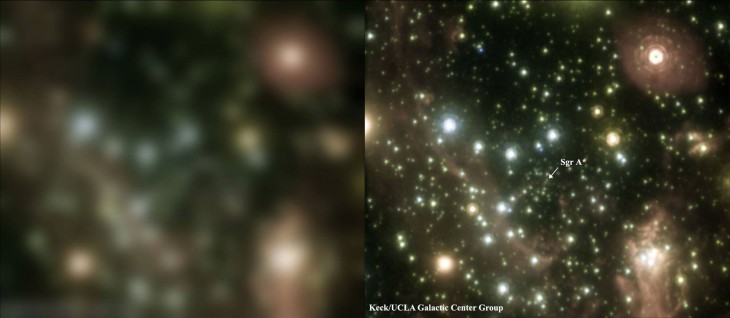From the Subaru Telescope to TMT

KASHIKAWA Nobunari, Associate Professor, National Astronomical Observatory of Japan
It has been fifteen years since the Subaru Telescope began operation. It stands as a symbol of the technology on which Japan prides itself. The telescope has been used to observe a wide range of astronomical objets throughout the universe, from the solar system to distant galaxies more than 10 billion light years away, and has produced a multitude of achievements. The Subaru Telescope has made a number of findings about the universe, and at the same time has presented us with many new questions. We have a boundless curiosity to peer into the unknown, and this pure desire to know more has driven us to reach even higher and build a new larger telescope. In this article, we introduce the TMT (Thirty Meter Telescope) that is currently being constructed and some of the new doors to the universe that it will open.
TMT plan
TMT will be built next to the Subaru Telescope on the summit of Mauna Kea on the island of Hawaii. It is the next-generation in large ground-based telescopes with a diameter of 30 meters (Image 1) (compared to the 8-meter diameter of the Subaru Telescope). International cooperation is essential to create such a large telescope. Five countries — Japan, the United States, Canada, China, and India — are currently working together to build the TMT, with each country providing technologies in which it excels.
Japan was selected to manufacture the main unit of TMT and part of the telescope’s primary mirror in light of its experience in manufacturing the high-performance Subaru Telescope. There are also plans to utilize Japan’s reliable precision technology in many other parts of the TMT. The primary mirror of the Subaru Telescope was made of a single mirror, but this cannot be applied to a mirror with a diameter of 30 meters. The primary mirror of TMT is designed to be made up of a combination of 492 small (1.44 meter diagonally) hexagonal mirrors (manufactured by Japan) that function as one larger mirror. For this reason, the precision of polishing and arranging these small mirrors needs to be approximately 10 nanometers (one nanometer equals one billionth of a meter).
 Image 1 : Rendering of TMT |
The telescope itself and the dome are also likely to be bigger than that of the Subaru Telescope because of the larger size of the mirror. However, they are designed to be kept to the minimum, with a light-weight yet sturdy structure. In addition, some observational instruments will be developed in cooperation with universities in Japan. The knowledge and experience gained from building and operating the Subaru Telescope will also be applied.
The TMT International Observatory was established in May 2014 as the organization in charge of constructing and operating the telescope. Construction is under way on the summit of Mauna Kea, and the manufacturing of the TMT structure and its primary mirror has partially begun in Japan. The TMT has 14 times as much light-gathering power as the Subaru Telescope, and boasts 15 times the resolution of the Hubble telescope. With these tremendous performance specifications, it aims to unravel a variety of mysteries in the universe (Image 2).
 Image 2: Comparison of simulation images of the galactic center by the Subaru Telescope (left) and TMT (right) |
TMT leads to new developments in astronomy
The advent of this large telescope is sure to advance the frontiers of a wide range of astronomy research fields. With TMT, you can see the internal structure of a galaxy that is more than 1.3 billion light-years away from that which can be seen within the limits of current specifications. It is 100 times more accurate in measuring metal abundances in outer space, and makes it possible to detect black holes one digit smaller in weight than those that can be detected now. With the TMT, it will be possible to observe the volcanic activity of Io, a satellite of Jupiter, and find extrasolar planets with an orbital radius that is one digit smaller than those that can be seen within the current limits.
It is only natural to assume that the use of a larger telescope will lead to more in-depth research. However, the TMT is not merely an extension of the Subaru Telescope. It is expected to bring about an entirely new paradigm of astronomy that has been impossible to pursue up until now. Here are three examples of the ways in which the TMT will change the face of astronomy.
(1) Discovery of the first galaxy born in the universe.
The Subaru Telescope has found many galaxies approximately 13 billion light-years away, but it has been determined that these were not the first galaxies. Galaxies that were born in the early days of the universe, a time in which no heavy elements existed, are expected to exhibit characteristics different from the galaxies we know. How were astronomical objects born in the universe? How were elements synthesized in the first star in the universe, and how were they diffused into the surrounding space? The TMT will investigate the mysteries of the origins of astronomical objects and elements.
(2) Existence of life in extrasolar planets.
The Subaru Telescope has detected more than 4,000 (extrasolar) planets outside the solar system, including candidates. Now people want to know whether extra-terrestrial life exists on these planets. Substances essential to life, such as oxygen and organic matters, can be found by observing the light reflected from the surface of a planet and the light of the primary star that passes through the planet’s atmosphere. The Subaru Telescope discovered a large extrasolar planet similar to Jupiter, but TMT will be able to detect smaller planets that are closer to their primary star, where life like that on Earth can exist. Will researchers find life there? The TMT will investigate the origins of life.
(3) Directly observe the expansion of the universe.
The variety of observations made over the years give support to the idea that the universe is expanding, but this interpretation involves a hypothesis and a theoretical model. If the universe is expanding, then it would be larger today than it was yesterday, and the distance between astronomical objects would be extending further. Existing telescopes are not able to measure this distance, but TMT may be able
to measure the change in distance by observing it twice over a ten-year period. Based on this measurement, researchers plan to directly measure the speed at which the universe is expanding. A great deal of technical difficulty is involved in achieving an unprecedented level of ultra-precise measurement and stability over a period of ten years, but these dream-inspiring observations have never been conducted before. The TMT will investigate the mystery of dark energy, which is believed to cause the universe to expand.
This telescope may change the very way in which we look at the world and the universe. Scheduled to begin observations approximately ten years from now, the TMT will show us the moment when a galaxy is about to be born, or provide us with views of a planet with water or oxygen. There are also plans for the TMT to conduct joint observations with the Subaru Telescope. With these two telescopes, Japan is expected to play a leading role in astronomy in the 2020s.
What is to be observed with this large telescope? Astronomers in Japan and other countries around the world are currently considering this question and presenting ideas. It will take time before these observations can be made, but it is fun to consider these exciting ideas before the construction of the TMT is complete. However, really interesting observations often come from where is least expected. This is because we ourselves know that in the case of the Subaru Telescope, the results obtained went far beyond expectations or were even unexpected, despite the variety of observation proposals that were made before the Subaru Telescope was constructed. This is why people find astronomy to be interesting, the universe mysterious, and nature profound. When the junior high and high school students of today grow up and make observations with an open mind, the greatest achievement of the TMT may be a great, surprising discovery that shatters common knowledge. We greatly appreciate the ongoing support and cooperation of everyone as the TMT slowly nears completion.
Translated from “Subaru kara TMT he (From the Subaru Telescope to TMT),” Kagaku, July 2015, pp. 0648-0650, ©2015 by Kashikawa Nobunari. Reprinted by permission of the author c/o Iwanami Shoten, Publishers. [July 2015]
]]>




